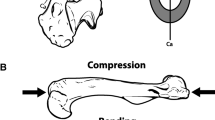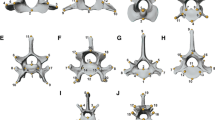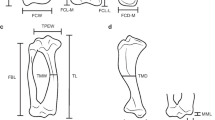Abstract
Mosimann and colleagues formulated a technique that distinguishes between size and shape, based on the concept of geometric similarity and the distinction between “log size-and-shape” and “log shape” variables. We extend these formulations in an examination of the forelimb of three callitrichid species (adultSaguinus oedipus, Saguinus fuscicollis, andCallithrix jacchus). We employ principal components analysis to explore the relationship between variance explained by size-and-shape versus shape alone. Independence of shape vectors is examined via correlation analysis. Then we use log shape data to construct intersample (species means) and total sample (between all paris of individuals) matrices of average taxonomic distances. These distance matrices are subjected to cluster analysis and principal coordinate ordinations. Results of principal components analysis suggest that after isometric size is removed, there remains sufficient shape information to discriminate among the three taxa. Careful examination and quantification of the relationships between shape and size suggest that size information (e.g., geometric mean) is fundamental for understanding shape differences within and among callitrichid species; in other words, most aspects of forelimb shape are significantly correlated with size. Contrary to conventional wisdom, we also demonstrate that such correlations are not “spurious”. Ordinations and clustering of log shape distance matrices (based on means and individuals) support the notion that, despite differences in size, the two tamarins are more similar in shape than either is toC. jacchus (despite size similarity betweenS. fuscicollis andC. jacchus). Although shape variation in the forelimb of calliirichids may have a functional component, the phylogenetic signal remains strong and serves to group individuals accordingly.
Similar content being viewed by others
References
Anderson, E. A. (1936). The species problem inIris. III. The phylogenetic relationship ofIris versicolor andIris virginica.Ann. Mo. Bot. Garden 23: 471–483.
Bass, W. M. (1987).Human Osteology: A Laboratory and Field Manual, 3rd ed., Special Publication No. 2, Missouri Archaeological Society, Columbia.
Bookstein, F. L. (1989). “Size and shape”: A comment on semantics.Syst. Zool. 38: 173–180.
Bookstein, F. L., Chernoff, B., Elder, R., Humphries, J., Smith, G., and Strauss, R. (1985).Morphometrics in Evolutionary Biology, Special Publication 15 Academy of Natural Sciences of Philadelphia.
Calder, W. A. (1984).Size, Function, and Life History, Harvard University Press, Cambridge, MA.
Cheverud, J. (1982). Relationships among ontogenetic, static and evolutionary allometry.Am. J. Phys. Anthropol. 59: 139–149.
Cheverud, J., and Richtsmeier, J. (1986). Finite-element scaling applied to sexual dimorphism: Rhesus macaques (Macca mulatta) facial growth.Syst. Zool. 35: 109–127.
Corruccini, R. S. (1973). Size and shape similarity coefficients based on metric characters.Am. J. Phys. Anthropol. 38: 743–754.
Corruccini, R. S. (1987). Shape in morphometrics: comparative analyses.Am. J. Phys. Anthropol. 73: 289–303.
Corruccini, R. S., Macchiarelli, R., and Bondioli, L. (1987). Le componenti di “forma” e “dimensione” in morfometria: un'analisi metodologica comparativa.Anthropol. Contemp. 10: 141–149.
Darroch, J. N., and Mosimann, J. E. (1985). Canonical and principal components of shape.Biometrika 72: 241–252.
Falsetti, A. B. (1986).Allometric Variation of the Postcranial Skeleton in Two South American Tamarins Saguinus oedipus oedipus and Saguinus fuscicollis illigeri (Callitichidae, Primates), Master's thesis, University of Tennessee, Knoxville.
Glassman, D. M. (1983). Functional implications of skeletal diversity in two South American tamarins.Am. J. Phys. Anthropol. 61: 291–298.
Gould, S. J. (1986). Allometry and size in ontogeny and phylogeny.Biol. Rev. 41: 587–640.
Gould, S. J. (1975a). Allometry in primates with emphasis on scaling and the evolution of the brain.Contrib. Primatol. 5: 244–292.
Gould, S. J. (1975b). On the scaling of tooth size in mammals.Am. Zool. 15: 351–362.
Hartman, S. E. (1988). Evaluation of some alterative procedures used in numerical systematics.Syst. Zool. 37: 1–18.
Howells, W. W. (1989).Skull Shapes and the Map: Craniometric Analyses in the Dispersion of Modern Homo, Papers of the Peabody Museum of Archaeology and Ethnology, Vol. 79, Harvard University, Cambridge, MA.
Humphries, J., Bookstein, F., Chernoff, B., Smith, G., Elder, R., and Poss, S. (1981). Multivariate discrimination by shape in relation to size.Syst. Zool. 30: 291–308.
James, F. C., and McCulloch, C. E. (1990). Multivariate statistical methods in ecology and systematics: Panacea or Pandora's box.Ann. Rev. Ecol. Syst. 211: 129–166.
Jolicoeur, P. (1963a). The degree of generality of robustness inMartes americana Growth 27: 1–27.
Jolicoeur, P., (1963b). The multivariate generalization of the allometry equation.Biometrics 19: 497–499.
Jolicoeur, P. (1984). Principal components, factor analysis, and multivariate allometry: A small sample direction test.Biometrics 40: 685–690.
Jungers, W. L. (1984). Scaling of the hominoid locomotor skeleton with specific reference to the lesser apes. In Preuschoft, H., Chivers, D., Brockelman, W., and Creel, N. (eds.),The Lesser Apes: Evolutionary and Behavioural Biology, Edinburgh University Press, Edinburgh, pp. 146–149.
Jungers, W. L. (1985). Body size and scaling of limb proportions in primates. In Jungers, W. L. (ed.),Size and Scaling in Primate Biology, Plenum Press, New York, pp. 345–381.
Jungers, W. L., and Harman, S. E. (1988). Relative growth of the locomotor skeleton in orang-utans and other large-bodied homonoids. In Schwartz, J. H. (ed.),Orang-utan Biology, Oxford University Press, Oxford, pp. 347–359.
Jungers, W. L., Cole, T. M., III, and Owsley, D. W. (1988). Multivariate analysis of relative growth in the limb bones of Arikara Indians.Growth Dev. Aging 52: 103–107.
Lele, S. (1991). Some comments on coordinate-free and scale-invariant methods in morphometrics.Am. J. Phys. Anthropol. 85: 407–417.
Lemen, C. A. (1983). The effectiveness of methods of shape analysis.Fieldiana Zool. NS 13: 1–17.
Lestrel, P. E. (1989). Some approaches toward the mathematical modeling of the craniofacial complex.J. Craniofac. Gen. Dev. Biol. 9: 77–91.
Martin, r. (1928).Lehrbuch der Anthropologie, Zeiter Band: Kraniologie, Osteologie, Verlag Gustav Fischer, Jena, Germany.
Masterson, T. J., and Leutenegger, W. (1990). The ontogeny of sexual dimorphism in the cranium of Bornean orang-utans (Pongo pygmaeus pygmacus) as detected by principalcomponents analysis.Int. J. Primatol. 11: 517–539.
McMahon, T. A., and Bonner, J. T. (1983).On Size and Life, Scientific American Library, W. H. Freeman, New York.
McKinney, M. L. (ed.) (1988).Heterochrony in Evolution: A Multidisciplinary Approach, Plenum Press, New York.
Mosimann, J. E. (1970). Size allometry: Size and shape variables with characterizations of the lognormal and gamma distributions.J. Am. Stat. Assoc. 56: 930–945.
Mosimann, J. E., and James, F. C. (1979). New statistical methods for allometry with application to Florida red-winged blackbirds.Evolution 33: 444–459.
Mosimann, J. E., and Malley, J. D. (1979). Size and shape variables. In Orloci, L., Rao, C. R., and Stiteler, W. M. (eds.),Multivariate Methods in Ecological Work. International Cooperative, MD, pp. 175–189.
Prothero, J. (1986). Methodological aspects of scaling in biology.J. Theoret. Biol. 118: 259–286.
Rao, C. R. (1971). Some notes on misspecification in multiple regressions.Am. Stat. 25: 37–39.
Rohlf, F. J. (1990). Morphometrics.Annu. Rev. Ecol. Syst. 21: 299–316.
Rohlf, F. J., and Bookstein, F. L. (eds.) (1990).Proceedings, Michigan Morphometrics Workshop, Department of Zoology, University of Michigan Press, Ann Arbor.
Shea, B. T. (1985). Bivariate and multivariate growth allometry: Statistical and biological considerations.J. Zool. London 206: 367–390.
Sneath, P. H. A., and Sokal, R. R. (1973).Numerical Taxonomy, Freeman, San Francisco.
Susman, R. L., and Creel, N. (1979). Functional and morphological affinities of the subadult hand (O.H. 7) from Olduvai Gorge.Am. J. Phys. Anthropol. 51: 311–331.
Author information
Authors and Affiliations
Rights and permissions
About this article
Cite this article
Falsetti, A.B., Jungers, W.L. & Colle, T.M. Morphometrics of the callitrichid forelimb: A case study in size and shape. International Journal of Primatology 14, 551–572 (1993). https://doi.org/10.1007/BF02215447
Received:
Revised:
Accepted:
Issue Date:
DOI: https://doi.org/10.1007/BF02215447




